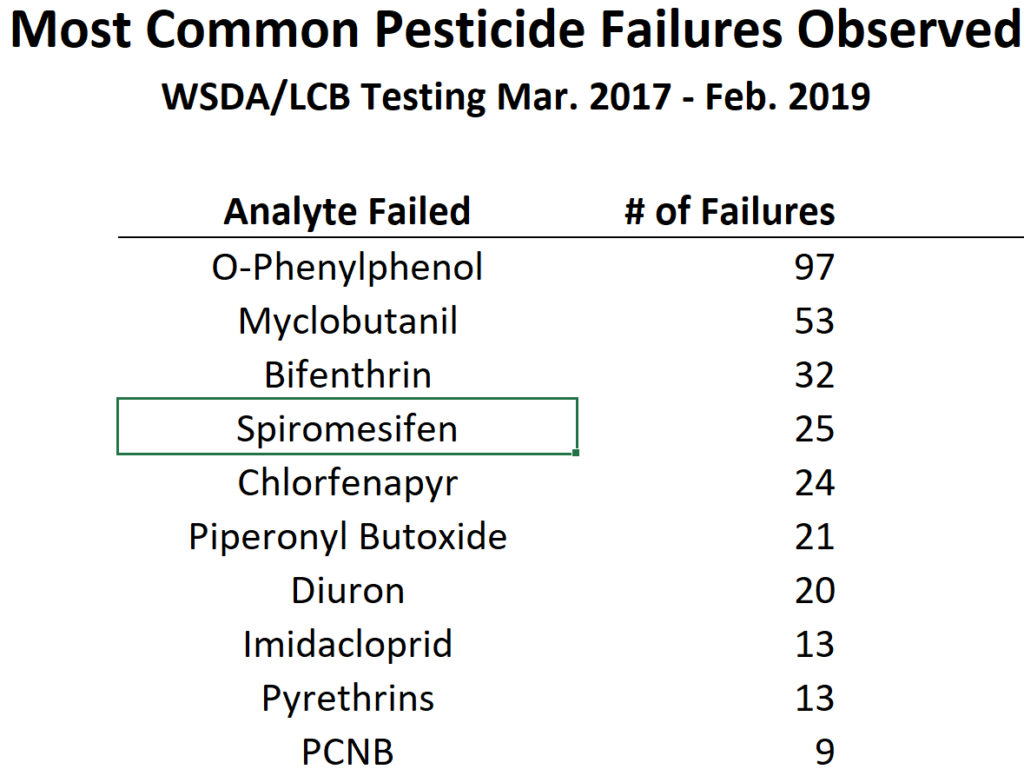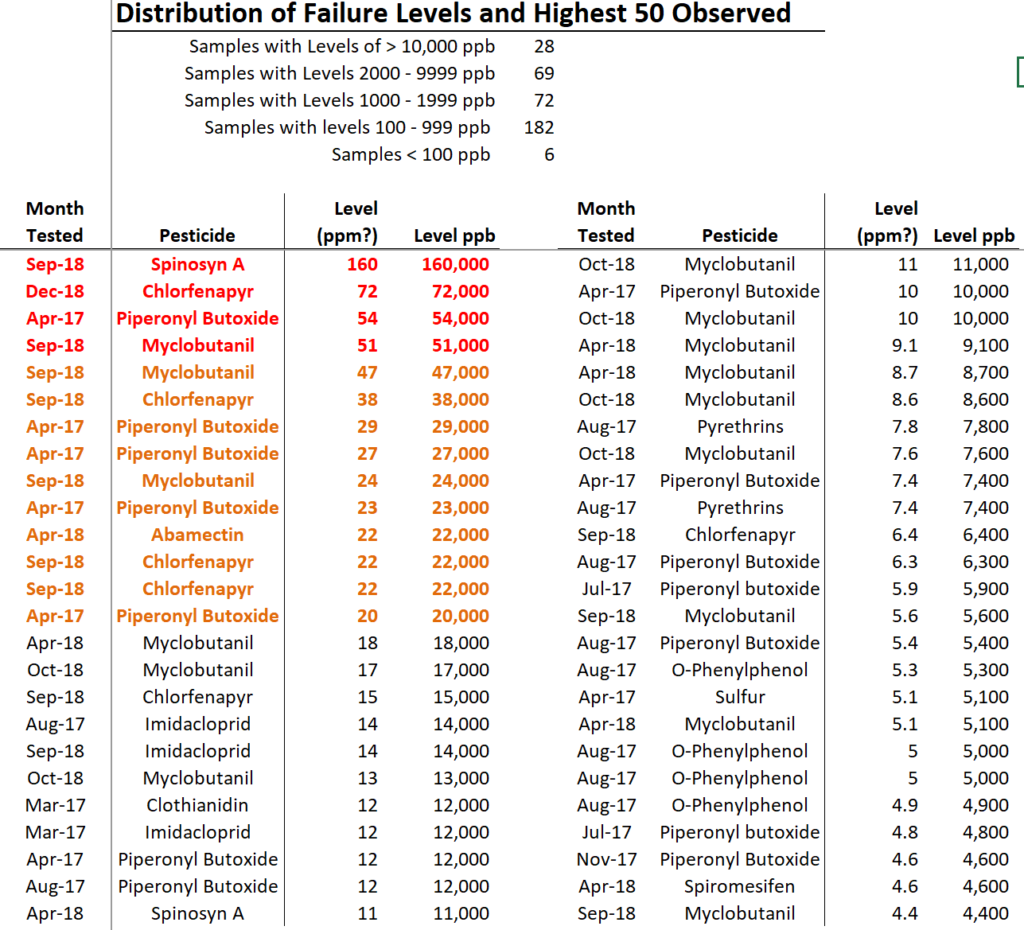
CORCs, the story continues, are willing to pay the inflated costs that come with high cannabis taxes and a strict regulatory ecosystem that create significant cost burdens for licensees BECAUSE the safety of regulated products has been regulatorily assured. The tax dollars paid by CORCs are fighting diversion, they are fighting organized crime, they are protecting children and they are paying for healthcare. CORCs are good for the state.
As I hint in the post below, CORCs in Washington state deserve more than the often inadequate products and information currently provided by it’s licensees and it’s regulators. They deserve much more.
Until April of 2022 (April Fool’s day), GORCs (Growers of Regulated Cannabis) in Washington were not required to test for pesticides — at all. That changed on April 2nd, 2022 when the LCB thought that the running 7-year-long joke on CORCs was getting stale and they finally got in line with every other legal state and required that pesticide testing be conducted.
In truth, pesticides don’t even appear to have been on the LCB’s radar until the “Patient Protection Act” mandated that our high-functioning medical cannabis industry be rolled into the I-502 adult-use regulatory structure. Someone in Olympia thought that very sick kids and adults using cannabis as medicine could use some protections that were apparently not relevant to general-purpose adult users.
As part of the Herculean effort undertaken by the state to keep patients protected, the DOH and WSDA and WSLCB and Governor and DOR got together and determined that medical cannabis patients required protection from pesticides and from 4 particular heavy metals. They were going to ensure that GORCs did not poison CORCs willing to source and pay for product adorned with the DOH certification of being “medical grade”.
Since CORCs represented what we now know to be the other 98.6% of cannabis users in the state, this protection against pesticides was not deemed sufficiently important to be applied. As long as DOH-certified medical-grade product was available to those at-risk types who know themselves to be sensitive to such things as cyanide, commerce could continue.
To show that they did not COMPLETELY not care about the safety of CORCs, the LCB implemented a program of random (and complaint-based) pesticide testing in partnership with the WSDA – a group that knows a thing or two about pesticides.
As a result of the ongoing Brewstergate controversy, it is very likely that a bunch of recent pesticide testing data will be coming to light in the next days and weeks. I have some of that in hand now, and I understand that a good deal more is on the cusp of being released. That is good. People should know what has REALLY been going on behind the scenes with regard to pesticide contamination in Washington’s regulated cannabis market.
The current post shares a summary of the results of the first two years of testing done by the WSDA/LCB joint venture. It does not include the names of any licensees … just a high-level summary of what was found testing over 500 samples taken from over 100 sampling events (probably over 75 licensees, but I don’t know for sure —- yet) and some details about what they detected during the period spanning March of 2017 through February of 2019.
Enjoy
WSDA / WSLCB Joint Venture in Cannabis Testing
The First Two Years
109 sampling events (cases) were reported with 587 samples tested for an average of 5.4 samples tested per event.
63 of these sampling events involved at least one sample that failed pesticide testing, for a licensee-level failure rate of 57.8% (a given licensee may well have received more than one sampling event — I can’t tell from the version of the data used in compiling this summary).
228 samples failed testing for at least one of the 200+ analytes (pesticides) assessed by the WSDA Yakima Hops Lab for a product failure rate of 38.8%
178 of the failed tests were for contaminant levels that exceeded the allowed “action level” limits by a factor of more than 2.
Failed samples displayed, on average, failed levels for 1.53 different pesticides.
Pesticides Most Commonly Causing Failures
Highest Pesticide Concentrations Observed
(warning — some of this is gross)
The following are the highest analyte concentrations observed in products that failed testing, with an indication of when the sample was tested and the degree of contamination. Note that not all pesticides are created equal and some of these are likely worse for consumers than others (myclobutanil, for example, partially converts to cyanide when heated to sufficient temperatures). Some may be relatively harmless. Some may have nutritive value.

Next Steps: The Recalls
One key regulatory goal that serves as a foundation of ensuring consumer safety in the face of known product contamination is the assurance that contaminated product be made unavailable to consumers as quickly as possible and that consumers be promptly informed so that any contaminated product they have on hand can be dealt with accordingly. To this end, states make different consumer-facing resources available to increase safety and health. Here are examples of how the two original “cannabis is legal” states approach this aspect of protecting those now providing cannabis-generated tax revenue to their respective state Governments:
The Washington state “Notice of Recalls” page is the Gold-standard for the communication of critical information to potentially-impacted consumers in the country. Soon to be adopted by CANNRA acolytes across the nation and world.
The Colorado state “MEDS Health and Safety Advisory” page is the way folks living too far away from the ocean and fresh seafood for their own good think that the CORCs and other interested parties of Colorado should be informed.
Take a look at each … I’d love to hear which state you think better serves the needs of it’s respective population of CORCs.
Final Thoughts — as it’s coming up on 4:20 on 4/20 — Ingesting pesticides by smoking has not been proven to be detrimental to your health. It’s also possible that cannabis’ medicinal effects help to offset the known toxicities associated with at least some pesticides. We just don’t know — and won’t until adequate research is funded and completed.
In spite of that, you are likely to hear a good deal about pesticides in general and pesticides in cannabis here in Washington in particular over the next while. Aside from that, little has changed in the quality and safety of the product in the regulated market in the 4+ years since the testing summarized here was conducted.
It is important to not over-react to what you see. This is going to take some time for the LCB, WSDA, DOE, DOH and Washington Farm Bureau to work through. While they are approaching a sensible and optimal direction forward, you can take comfort in knowing that, aside from a chemist that works or recently worked in enforcement down at the LCB, no-one has reported any clusters of unexpected poisonings linked to pesticide-contaminated cannabis.
Then again, dead CORCs tell no tales.
Enjoy what is left of 4/20